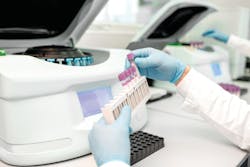Artificial intelligence pushes lab automation forward
In a healthcare environment where clinicians and patients demand accurate diagnosis faster, laboratory professionals have turned to automated analyzer technology to replace time and labor-intensive manual analysis.
“Machine learning in microbiology represents a much-needed advance,” said Glen Hansen, PhD, Medical Director Microbiology & Molecular Diagnostics Laboratory at Hennepin County Medical Center. “It’s the distinction between robotics and software that can aid in decision making processes in the lab and this is a big distinction.”
Looking forward, experts anticipate the use of AL/ML in automated analyzers will broaden in scope to encompass the entire testing continuum from research and development (R&D) through to proactive patient diagnosis and treatment.
In this article, manufacturers and users of automated analyzer technology share their insights on the current and future state of AL/ML, offering examples of where these advances provide benefit to laboratory professionals and patients.
Streamline workflows
“BD has watched how specimens make their way through labs and we’ve seen how much handling was needed both before and after the test,” said Story. “We also heard firsthand from customers that laboratory instruments have begun to manage them and their time instead of helping them improve efficiency of the lab. Systems that help address these needs, using AI and automation, give control back to medical laboratory scientists in high-throughput and large-scale laboratories.”
Story says cervical cancer screening with HPV extended genotyping has been a key focus area for complete molecular laboratory workflow automation given the hundreds of thousands of women who are tested each year.
“When robotics facilitates the processing of samples directly from liquid-based cytology vials, the creation of molecular aliquot tubes and assay testing — you cut out a lot of labor-intensive and error-prone manual processes,” she explains. “Plus, being able to rely on onboard capacity for reagents and samples to provide hours of unimpeded system processing eliminates multiple technologist interactions currently required per shift.”
Triage and organize specimens
According to Hansen, automation in plate reading and antimicrobial susceptibility testing are the most visible applications of AI/ML in laboratories today. He states that “AI/ML is currently being applied to microbiology plate reading, which has shown advances in accuracy and workflow efficiencies. Automated blood culture cabinets, which remove negative cases from the workflow and reduce time to reporting, have also recently been widely accepted.”
“Labs benefit from providing better ‘tools’ to the workforce and software and machine learning opportunities represent a chance to focus the work we do on cases that are of critical importance while targeting the work that we do in the lab to those aspects of reporting that require our attention,” Hansen added.
“We are using it (the solution) to triage plates with growth and without growth, so that the MLS can spend more time focusing on the cultures that need their expertise to interpret,” Woodward added. “It doesn’t make sense, especially with this technology, to utilize our highly trained MLS personnel to read/interpret no growth plates.”
Urine cultures, which make up a significant part of many labs’ daily workload, is one prime area for automated sample triage because the majority of samples either have no growth or non-significant growth and, therefore, don’t require additional work-up, Story explains:
“Batch review and release of large volumes of plates with non-significant growth can help medical laboratorians focus their time and expertise on more clinically relevant tasks and complex specimens,” Story said.
Achieve fast and accurate diagnosis
Hansen points to the “speed and accuracy with which molecular testing for COVID-19 entered the clinical space” as an example of how AI/ML can be leveraged to bring needed diagnostics to the lab in a faster, more accurate and less expensive manner, compared to previous development routes.
“Within the molecular space, AI was used to screen genetic material of COVID-19, providing a blueprint of the virus without ever having access to live virus. The application of AI for molecular test development allowed COVID-19 PCR test kits to be developed in weeks versus months,” he states.
Differentiate between conditions
Experts say advanced automation of laboratory technology enabled by AI and ML can help labs differentiate between conditions, providing patients with more accurate results in a shorter time period.
“I have only seen a few conference posters or examples where AI/ML could help,” Andrada explained. “It could potentially be used to help with pattern recognition of immunofluorescence assay (IFA) results for Antinuclear Antibodies (ANA) testing. This is a common test ordered to help with autoimmune diagnosis. This sounds intriguing to me, especially since IFA is a bit subjective and requires significant training to interpret the many different IFA patterns a sample could have.”
“Recent reports show that the flu and COVID-19, for instance, can occur simultaneously in a patient. Flu or other respiratory viruses, as well as COVID-19 symptoms, overlap, making a non-tested diagnosis, challenging. By using a multiplex test and analyzer, designed using AI, practitioners would be able to detect and differentiate between multiple targets, eliminating the need for multiple tests. Additionally, these diseases can be detected early and, therefore, treated quickly. Using AI/ ML would also reduce the time taken to design and manufacture assays, from months to a few weeks.”
Verify results
“A routine urinalysis increases workload when technicians must confirm the analyzer’s findings or identify unique particle types (manual microscopic reviews are time-consuming and can take up to six times longer per sample than with an automated system),” 1 Carlsgaard explains. “Digital flow morphology technology with Auto-Particle Recognition Software can enable laboratories to deliver standardized results. This technology isolates, identifies, and characterizes urine particles to provide immediate, accurate, and reproducible results verified directly on the screen.”
Automate quality assurance checks
Noting how clinical laboratories have taken significant steps in the use of rule-based functions to improve efficiencies, Carlsgaard describes how AI/ML can be used to streamline quality control (QC) checks.“For example, if QC is being run on an instrument every eight hours, it’s a standardized check. With auto QC, patient results are reviewed continually to determine if they are trending toward normal or extended ranges — so that the laboratorian can be alerted if some thresholds are crossed, which we know, based on rules and past data, may lead to problems with QC. Because if we wait for the regular QC, which is conducted every eight hours, we may find out what’s wrong after it’s too late and must invalidate and re-run a significant number of tests,” he said.
Enhance staff training
Another area where Woodward and her team at UMC Health System are leveraging AI and ML is in the training of new lab employees. Because the solution they are using captures images of culture growth, they can save and store rare organisms for training purposes.
“There are situations that only arise every 5+ years in the microbiology laboratory, and now we can use the software to give our new people a leg-up in recognizing these situations,” Woodward explained. “Prior to the AI/ML, we depended heavily on having a long-term experienced MLS available to recognize and help the newest MLS. This meant reading cultures for multiple days and scheduling multiple people to read behind each other to not miss these rare situations. Now, with the AI/ML, we can give the newest MLS employees that knowledge earlier in their career before they’ve potentially missed a critical result for a patient.”
When asked where they see AI/ML being used in the future when it comes to lab analyzers, our experts pointed to everything from research and development (R&D) efforts to identifying organisms in patient samples.
Rapid R&D
“Machine learning-based diagnostic analyzers will be the key to simplifying and automating the R&D process, allowing scientists to respond rapidly to widespread testing needs,” said Larida, pointing to the use of ML and AI in the battle against SARS-CoV-2. He notes how scientists have already leveraged these advanced technologies in diagnosis, treatment and vaccine development efforts throughout the COVID-19 pandemic.
Colony identification
Woodward believes the “sky’s the limit” when it comes to the application of AI/ML in the lab environment. She hopes to see AI/ML becoming more robust in recognizing colors and growth patterns to determine how many colony types are growing in any given culture.
“AI/ML is able to offer identification suggestions, based on the color that grows on that media type. However, I’d like to see this expanded out to other routine media types so that we can utilize the AI/ML in more culture sources such as tissue, wound, respiratory, etc.,” Woodward explains. “I’m not sure I’m totally comfortable with AI/ML being able to identify organisms from the routine agar yet, but being able to differentiate multiple colony types and give the MLS an idea of how many organisms they may be looking for would be very helpful in interpreting cultures on the first read.”
Meaningful worklists
Story sees AI and ML being leveraged to “automatically organize specimens into meaningful worklists driven by user-defined expert rules for critical criteria such as ‘high risk patients’ or ‘complex specimens.’” She explains how this would help labs professionals work more efficiently by prioritizing their efforts on the most critical and complex specimens, stating, “Reading plates is one of the laboratory tasks that requires the most skill and, given the decrease of skilled technicians entering the workforce and the strain on resources created by the COVID-19 pandemic, it’s that much more critical for labs to be able to be more efficient by taking advantage of automation.”
Disease differentiation
As Andrada noted, AI/ML holds tremendous potential for running tests for autoimmune diagnosis. He said, “I expect to see AI/ML used in future algorithmic analysis of data to help or increase the confidence of diagnosing a specific autoimmune disease from several potential disease states.”
Patient feedback loops
Carlsgaard believes the benefits of AI-enabled technologies will go beyond operational efficiency to transform patient care delivery. “With AI, we can detect patterns hidden in large amounts of data and predict the future, which is the backbone of both automation and decision support. AI-enabled technologies, in the future, will come together to create data feedback loops to help improve not only efficiencies but transform patient care from ‘sick care’ to ‘well care.’ The journey has already begun,” he said.
Considerable change
Hansen comments on how the application of AL/ML in clinical microbiology could contribute to the considerable change we are already seeing in the field, stating, “The reality of the global Sars2-covid-19 pandemic has forever shaped the field of clinical microbiology and placed emphasis on accuracy, efficiency, and support of a critical underappreciated workforce in need of new diagnostics support tools. However, it’s also the craziest of times when one realizes the greatest opportunities for change and adaptation.”
References
- Block D. Automated urinalysis in the clinical lab. Medical Laboratory Observer. https://www.mlo-online.com/home/article/13004799/automated-urinalysis-in-the-clinical-lab.Published October 19, 2012. Accessed August 2, 2021.
About the Author

Kara Nadeau
has 20+ years of experience as a healthcare/medical/technology writer, having served medical device and pharmaceutical manufacturers, healthcare facilities, software and service providers, non-profit organizations and industry associations.






